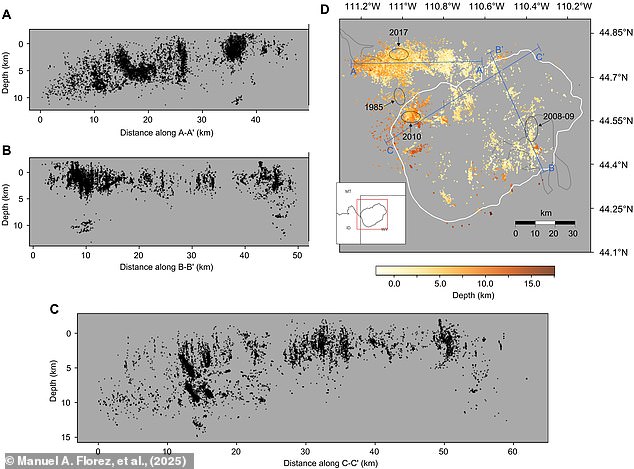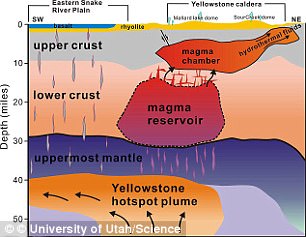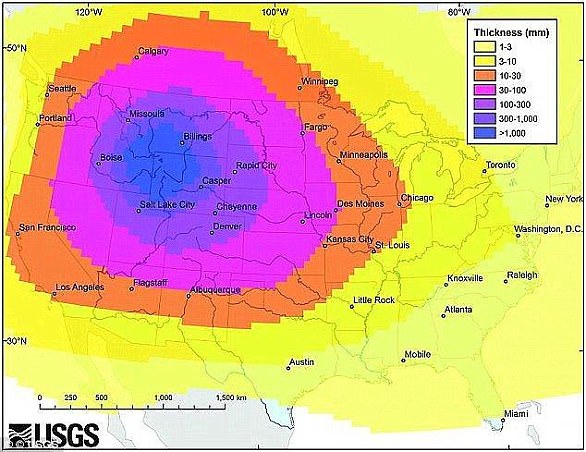Scientists have discovered an ominous sign which could hint that Yellowstone’s supervolcano is building up to an eruption.
Using machine learning, researchers found there have been over 86,000 hidden earthquakes between 2008 and 2022.
That is 10 times more tremors than scientists had previously detected.
Worryingly, more than half of those earthquakes came in swarms – small groups of interconnected tremors – which have been known to precede volcanic activity.
The researchers say these ‘chaotic’ swarms were found moving along rough, young fault lines running deep below the Yellowstone Caldera.
These clusters of seismic activity are likely caused by hot, mineral-rich water forcing itself through cracks in the rock.
Yellowstone is one of the world’s largest active volcanoes – and if it erupted, it would cover up to two-thirds of the US with ash.
Entire states could become uninhabitable as toxic air sweeps through them, grounding thousands of flights and forcing millions to leave their homes.

Scientists have spotted an ominous sign that the supervolcano below Yellowstone (pictured) could be building up to an eruption
The Yellowstone Caldera is a 30×45 mile (50×70 km) depression which was formed by a cataclysmic eruption some 640,000 years ago.
After the eruption emptied out its enormous magma chamber, the land left on top collapsed into the hollow space to form the caldera.
When scientists want to look for seismic activity around the caldera, they normally have to manually inspect vast amounts of data.
However, by using machine learning techniques, Dr Li and his co-authors were able to comb through years of past seismic recordings to look for previously undetected tremors.
Dr Bing Li, an expert on earthquake mechanics from Western University, says: ‘If we had to do it old school with someone manually clicking through all this data looking for earthquakes, you couldn’t do it. It’s not scalable.’
This revealed that tens of thousands of earthquake swarms had been missed by earlier manual inspections.
Earthquake swarms are not like the familiar shock and aftershock pattern where one big event is followed by a number of smaller tremors.
Instead, swarms occur as clusters of small earthquakes which rapidly spread and shift over a small area within a short period of time.

Scientists used machine learning to detect over 86,000 hidden earthquakes between 2008 and 2022. That is ten times more earthquakes than had previously been spotted. These graphs show where they were found, as well as how deep and far along the fault they occurred

The researchers say these ‘earthquake swarms’ are likely caused by the movement of superheated liquids beneath the volcano caldera. These same geothermal processes are the reason that Yellowstone produces its famous geysers
In some cases, this can be caused by molten magma moving upwards through the mantle and crust, building up pressure which can hint at an upcoming eruption.
However, volcano experts say this is likely not the case in the Yellowstone Caldera.
Professor Valentin Troll, a volcano expert from Uppsala University in Sweden who was not involved in the study, told MailOnline: ‘The seismic record reveals episodic activity that occurs in clusters within the upper 10 km beneath the volcano, primarily along pre-existing fault structures.
‘These clusters are not associated with deep seismicity; in other words, there is no direct evidence of magma recharge from greater depths. Instead, the seismicity is largely confined to the interior of the volcano.’
This kind of activity within the existing volcano is usually caused by the movement of gases and liquids disturbing the ground.
As the authors suggest, pressurised liquids are a particularly likely culprit since they lubricate faults in the rock, leading to slips that cause earthquake swarms.
Professor Troll says that this can lead to ‘hydrous and gas-driven eruptions’ in which steam or gases are ejected out of the ground.
This was demonstrated by the hydrothermal explosion at Yellowstone’s Biscuit Basin last summer, in which a blast of steam sent rocks flying hundreds of feet into the air.

Experts say the swarm activity is not an indication of an upcoming major eruption but could lead to ‘hydrous and gas-driven’ eruptions like those which caused a major explosion at Biscuit Basin last summer (pictured)

This comes after a new pool appeared at Yellowstone National Park (pictured), likely formed in a series of mildly explosive events between late December 2024 and early February 2025. The rocks and white material (silica mud) surrounding the pool were probably ejected as the feature formed
Similar explosions are the likely cause of a 13-foot pool which recently appeared at Norris Geyser Basin – one of the hottest, oldest and most dynamic of Yellowstone’s thermal areas.
However, these swarms are not an indication that a devastating magma-driven eruption is on the way.
Instead, the researchers say that their findings are a valuable tool to help understand and prepare for other eruptions in the future.
These same machine learning techniques could be applied to other historical seismic records to help scientists listen to ‘Earth’s volcanic heartbeat’.
Dr Li says: ‘While Yellowstone and other volcanoes each have unique features, the hope is that these insights can be applied elsewhere.
‘By understanding patterns of seismicity, like earthquake swarms, we can improve safety measures, better inform the public about potential risks, and even guide geothermal energy development away from danger in areas with promising heat flow.’


